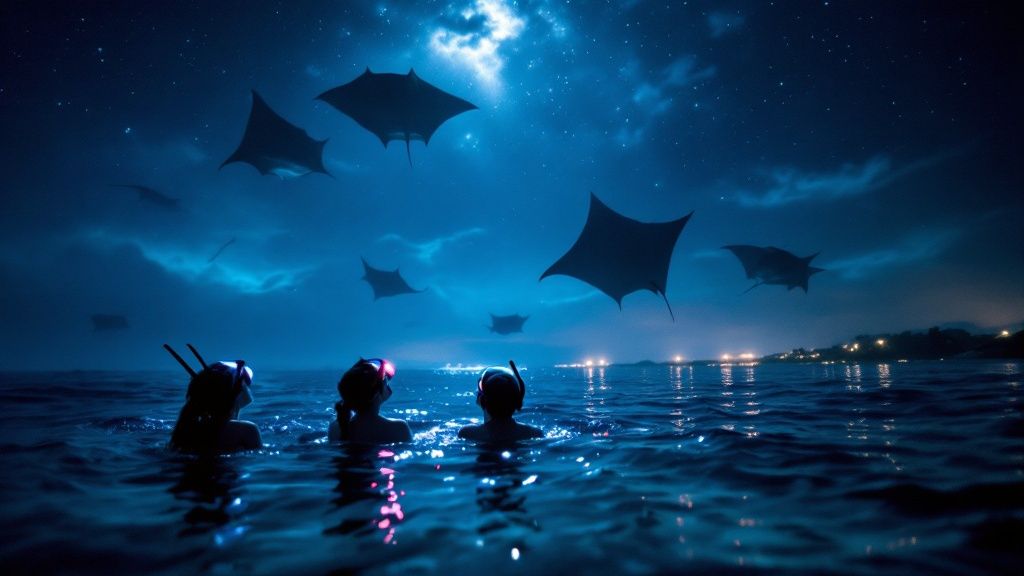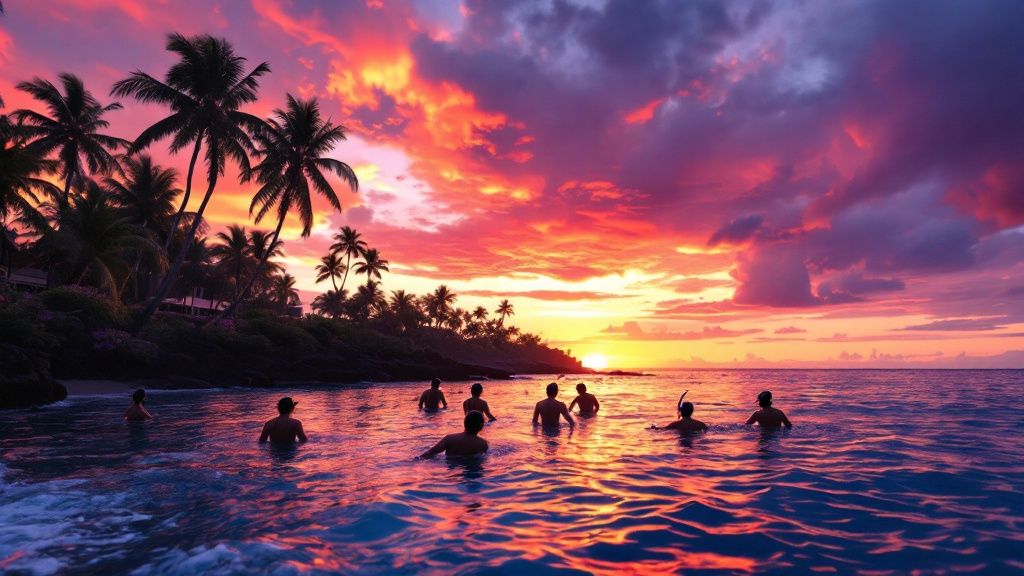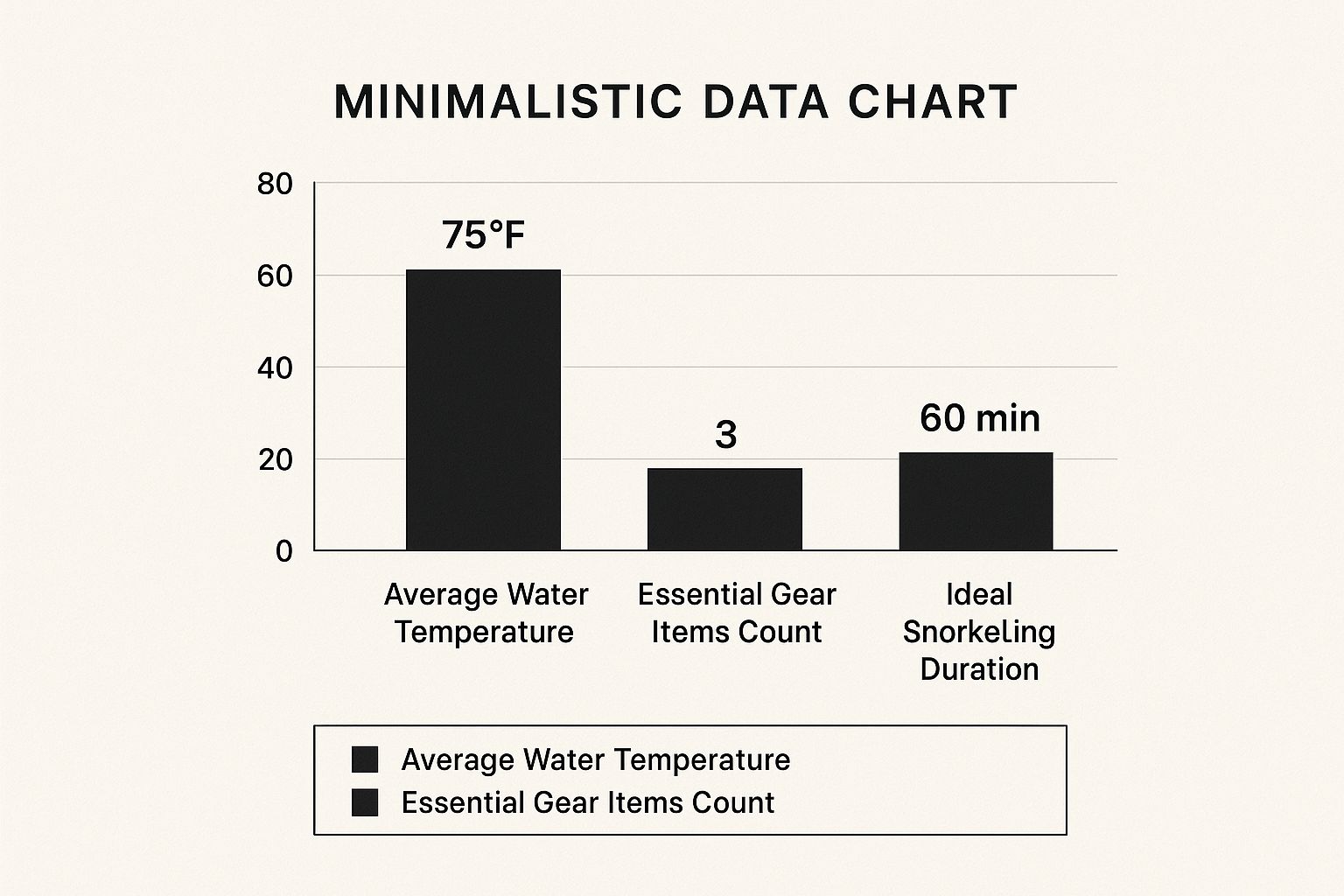Manta Ray Snorkel Kona: Your Complete Hawaii Adventure Guide
- Byron
- May 26
- 11 min read
Why Kona Reigns Supreme For Manta Ray Encounters
Kona, Hawaii, is more than just a beautiful island getaway; it's a globally recognized haven for manta ray encounters. This isn't a coincidence. A special blend of environmental factors makes Kona the perfect habitat for these gentle giants, attracting researchers and snorkelers alike. This underwater paradise offers a unique glimpse into a thriving ecosystem.

The Perfect Recipe for Manta Ray Heaven
Kona's nutrient-rich waters teem with microscopic life, the very base of the manta ray's diet. These waters are particularly rich in plankton, the manta ray's main food source. This plankton abundance isn't accidental; it's due to Kona's unique underwater topography and currents. These currents carry nutrient-rich water from the deep ocean up to the shallower coastal areas, creating a buffet for plankton, and in turn, for manta rays. Kona's sheltered bays also provide calm waters, ideal for these graceful creatures to feed peacefully.
Keauhou Bay: A Manta Ray Hotspot
One specific spot stands out: Keauhou Bay. Here, the renowned Manta Village draws visitors worldwide. The bay's calm, shallow waters create a perfect environment for both manta rays and snorkelers. Tour operators utilize innovative lighting systems that mimic natural moonlight, attracting plankton, and consequently, the manta rays, closer to the surface. This gives snorkelers an exceptional, up-close view of these magnificent animals performing their feeding rituals. Check out this guide on underwater photography: How to master underwater photography with a GoPro.
Kona: A Global Phenomenon
This unique ecosystem has transformed Kona into a worldwide phenomenon for manta ray snorkeling. Manta ray night snorkeling tours in Kona have become incredibly popular, attracting approximately 80,000 people each year. This remarkable popularity stems from incredibly high sighting rates, with reputable tour operators reporting that between 80% and 90% of guests see manta rays on their tour. Find more detailed statistics here. This makes Kona a prime location for anyone wanting a guaranteed close encounter with these gentle giants.
Sustainability and Research
Kona's manta ray tourism success isn't solely about attracting visitors; it's about protecting this amazing ecosystem. Local research organizations are crucial for monitoring manta ray populations, studying their behavior, and promoting sustainable tourism practices. Their work contributes to global manta ray conservation efforts, ensuring these magnificent creatures continue to thrive. This focus on sustainability ensures the magic of Kona's manta ray encounters remains, while protecting the very environment that makes it all possible. Learn more about these mesmerizing creatures: Exploring the underwater night ballet. The blend of natural wonders and scientific understanding makes Kona an unparalleled destination for manta ray experiences.
Keauhou Bay Magic: Where Manta Dreams Come True

Keauhou Bay, nestled along the Kona coast of the Big Island, is more than just a picturesque bay; it's a world-renowned sanctuary for manta ray snorkel Kona excursions. Home to the celebrated Manta Village, this special location offers an exceptional opportunity to witness these gentle giants in their natural habitat. The bay's tranquil, shallow waters provide the perfect backdrop for a truly unforgettable experience.
The Allure of Manta Village
What distinguishes Keauhou Bay are its reliably calm waters and the clever lighting systems used by tour operators. These specialized lights, strategically positioned beneath the surface, attract large amounts of plankton. This creates an enchanting underwater feast that draws in the manta rays, allowing them to perform their elegant feeding ballet just feet away from captivated snorkelers.
A Nighttime Spectacle
As darkness descends, the bay transforms into a magical arena. The underwater lights illuminate the scene, revealing the manta rays' graceful movements as they glide and twirl through the water. They often perform impressive barrel rolls and backflips while feeding on the plankton, a truly captivating display. This nightly ritual is a unique experience, turning Keauhou Bay into a natural wonder.
Why Keauhou Bay is Ideal for Manta Ray Snorkel Kona
This sheltered bay offers perfect conditions for both manta rays and people. The calm, clear water ensures great visibility, even at night. The bay’s sheltered location protects it from strong currents and waves, creating a comfortable and safe snorkeling environment, ideal even for beginners. Keauhou Bay’s Manta Village is the heart of Kona's manta ray snorkeling, known for its high sighting rates and calm waters. Learn more about Manta Ray sightings. This makes it a prime location for anyone seeking a close encounter with these gentle giants.
The Magic of Multiple Mantas
One of the most remarkable aspects of snorkeling in Keauhou Bay is the chance to see multiple manta rays feeding simultaneously. This creates a dynamic and unforgettable underwater ballet. Imagine several of these magnificent creatures, with wingspans reaching up to 16 feet, gracefully navigating the illuminated water, mere inches away. This is what makes a manta ray snorkel Kona experience at Keauhou Bay truly special.
An Accessible Adventure
The relatively shallow depth makes this experience accessible to a wide range of people, from experienced snorkelers to first-timers. This combination of accessible conditions and guaranteed excitement makes Keauhou Bay a truly special destination. Choosing a manta ray snorkel Kona tour in Keauhou Bay promises an experience unlike any other. The magic of witnessing these creatures in their natural habitat is remarkable. The serene waters, the vibrant plankton, and the graceful dance of the manta rays create an unforgettable experience. This makes Keauhou Bay a must-visit for anyone seeking a close encounter with the wonders of the ocean.
Finding Your Perfect Manta Ray Snorkel Kona Experience
Not all manta ray tours are created equal. Choosing the right tour operator can significantly impact your Kona manta ray adventure. Understanding the differences between tours is essential for an unforgettable experience. Let’s explore the key factors to consider when booking your tour.
Small Group vs. Large Group Tours
One of the first decisions you'll make is choosing between a small group or a large group tour. Small groups, often limited to six or eight people, offer a more personalized experience. You’ll have greater interaction with your guide and more opportunities to ask questions. Larger tours can be more economical, especially for families. Consider your personal preferences and budget when making this decision. For more helpful tips, check out this article on choosing the best manta ray Kona tour.
Key Factors in Tour Selection
Besides group size, other vital elements contribute to an amazing manta ray encounter. These factors can greatly influence your overall satisfaction.
Safety Protocols: Always inquire about the operator's safety procedures and emergency plans. A reputable operator prioritizes guest safety.
Equipment Quality: Comfortable, well-maintained equipment is crucial. Ensure the provided wetsuits, masks, and snorkels fit properly and are in good condition.
Guide Expertise: A knowledgeable guide enriches your experience. Look for guides experienced with manta ray behavior and the local marine ecosystem. They can provide valuable insights into these magnificent creatures.
Understanding Pricing and Booking
The infographic below highlights key data related to manta ray snorkeling conditions: average water temperature (75°F), essential gear items (3), and ideal snorkeling duration (60 minutes).

This means you should dress appropriately for the water temperature, bring essential gear, and plan for about an hour of snorkeling. Pricing varies depending on factors like group size, tour duration, and included amenities. Remember that value is just as important as price. Booking in advance, especially during peak season, is highly recommended.
To help you choose the right tour, we've compiled a comparison guide of different operators in Kona:
Kona Manta Ray Tour Comparison Guide: Comparison of different tour operators, group sizes, duration, pricing, and special features to help you choose the best manta ray snorkel experience.
Tour Operator | Group Size | Duration | Price Range | Special Features |
|---|---|---|---|---|
(Example Operator 1) | 6-8 | 2 hours | $150-$200 | Small group, personalized experience |
(Example Operator 2) | 10-15 | 1.5 hours | $100-$150 | Larger group, more budget-friendly |
(Example Operator 3) | 12-20 | 2 hours | $120-$180 | Includes underwater photography |
(Example Operator 4) | 8-12 | 1.5 hours | $130-$170 | Focus on education and conservation |
This table provides a general overview. Remember to contact operators directly for the most up-to-date information.
Making Informed Choices for Your Adventure
Don't hesitate to contact tour operators directly with specific questions. Avoid operators who guarantee sightings, as manta ray encounters are influenced by natural factors. Be wary of overcrowded boats and aggressive marketing tactics. A thoughtful approach benefits both you and the manta rays. By carefully considering these factors, you can contribute to sustainable tourism and create an unforgettable experience.
Your Night With The Mantas: What Really Happens
So, you're ready for a manta ray snorkel Kona adventure? It's more than just a dip in the ocean; it's an experience. Let's walk through a typical evening, from boarding the boat to that unforgettable moment when a manta glides beneath you.
From Boat to Briefing: Getting Started
Your adventure begins as you board the boat, usually around sunset. The crew will fit you with your snorkeling gear: a wetsuit, mask, snorkel, and fins. They'll also provide a flotation device, often a pool noodle, to help you stay afloat and conserve energy. Don't worry if you're nervous; the crew will give a thorough safety briefing covering everything you need to know.
Lights, Camera, Plankton: Setting the Stage
Once the boat reaches the designated manta ray viewing area, like Keauhou Bay's Manta Village, the crew lowers special lights into the water. These lights attract plankton, the manta rays' main food source. This creates an irresistible feast, drawing these magnificent creatures closer to the surface. This careful setup sets the stage for an unforgettable encounter.
The Underwater Ballet: An Unforgettable Encounter
As darkness envelops the ocean, shadowy figures emerge. Drawn by the illuminated plankton, manta rays begin their mesmerizing underwater ballet. They glide effortlessly, their enormous wingspans creating an awe-inspiring spectacle. You might witness barrel rolls and backflips as they feast, a breathtaking display of agility and grace. This close encounter with these gentle giants is the highlight of the experience. You might be interested in Experiencing magical night encounters.
Water Conditions and Sensations
The waters around Kona are typically calm and warm, making for a comfortable snorkeling experience. Floating in the dark ocean, surrounded by the gentle glow of the underwater lights, adds a touch of wonder and tranquility. However, remember you'll be in open water at night. Staying close to the boat and your group is essential for safety and comfort. These are wild animals in their natural environment, so their behavior can be unpredictable.
Realistic Expectations and Addressing Concerns
While most tours boast high sighting rates, it's important to have realistic expectations. Manta rays are wild animals, and sightings aren't guaranteed. Many tour operators offer a "manta guarantee," allowing you to re-book if mantas aren't sighted on your first trip. Addressing concerns about night snorkeling is also crucial. First-time snorkelers might feel apprehensive about being in the dark ocean. Experienced guides, flotation devices, and staying with the group ensure a safe and enjoyable experience. For those prone to seasickness, taking precautions beforehand is advisable. The experience itself tends to overshadow any initial anxieties. Research even shows the power of storytelling: narrative structures receive 27% more citations and have 58% higher reader engagement. Read the full research here. Sharing your manta ray experience through stories makes it even more engaging.
The Science Behind Kona's Manta Ray Success Story
Kona, Hawaii, is renowned for its consistent manta ray sightings. This isn't just a lucky coincidence, but rather the result of a fascinating combination of biological and environmental factors. These factors create a perfect sanctuary for these gentle giants, making a manta ray snorkel in Kona a truly unforgettable experience. Let's explore the science that makes this underwater paradise so special.
The Plankton Buffet: A Feast for Gentle Giants
Manta rays, with their impressive wingspans, might appear to require massive meals. Surprisingly, these graceful creatures primarily dine on tiny organisms called zooplankton. Kona's waters, rich in nutrients, are teeming with zooplankton due to a unique combination of deep ocean currents and volcanic activity. These currents bring nutrient-rich water to the surface, creating a vast buffet for plankton, which, in turn, sustains the manta ray population.
Keauhou Bay: The Perfect Manta Village
Keauhou Bay, home to the aptly named Manta Village, provides an especially rich feeding ground. The bay's shallow and sheltered waters offer ideal conditions for zooplankton to flourish. This natural abundance is enhanced by the specialized lighting systems employed by tour operators. These lights, mimicking the natural moonlight, attract even more plankton, and, as a result, more manta rays gather for the feast.
Sustainable Tourism: Protecting Our Underwater Friends
You might be interested in learning more about the magical experience: Manta Ray Kona Hawaii: Into the Underwater Night Ballet. The thriving manta ray snorkel industry in Kona is not only focused on providing unforgettable experiences but also on protecting these magnificent creatures. Sustainable tourism practices are essential for preserving the delicate balance of this unique ecosystem. These practices involve minimizing disruptions to the manta rays and their habitat, promoting responsible viewing, and supporting research efforts.
The Importance of Research: Understanding Manta Rays
Local research organizations play a crucial role in understanding and safeguarding Kona's manta rays. They study the manta rays' behavior, monitor their populations, and track the overall health of the ecosystem. This research yields invaluable data that informs conservation initiatives, not just in Kona but globally. This dedicated effort ensures the long-term health and sustainability of the manta ray population and the snorkel experiences they provide.
A Decade of Success: Consistent Sightings and Thriving Populations
The success of Kona's manta ray tourism is well-documented. Historical data reveals a remarkable story of consistent growth and incredible sighting reliability. For instance, sighting statistics from 2009 through 2014 highlight the robust presence of manta rays along the Kona Coast, with consistently documented encounters in detailed annual reports. You can find more detailed statistics here: Manta Ray Statistics. This consistent presence emphasizes the effectiveness of ongoing conservation efforts and the significance of sustainable tourism practices. The collaborative partnership between researchers, tour operators, and the local community has been key to preserving this extraordinary underwater haven. The combination of ideal environmental conditions and responsible human interaction has created a true success story for both the manta rays and the people who come to admire them.
Planning Your Ultimate Manta Ray Adventure

Turning your Kona manta ray snorkel dreams into reality begins with thoughtful planning. This involves considering everything from the ideal time of year to having the proper equipment. This guide offers valuable insights and logistical tips to make your manta ray experience truly exceptional.
Timing is Everything: Seasonal Considerations and Moon Phases
Manta rays grace the waters of Kona year-round. However, specific times provide optimal viewing conditions. Summer (June-August) typically offers calmer waters and enhanced visibility.
The moon phase also plays a crucial role. A new moon creates a darker environment, amplifying the visibility of plankton and the manta rays that feed on them under specialized lights. This results in a more dramatic and captivating encounter.
Gearing Up for Success: Essential Equipment and Fitness
The right gear ensures comfort and maximizes your enjoyment. Most tour operators provide wetsuits, masks, snorkels, and flotation devices. Bringing your own well-fitting snorkel gear, especially a mask, can significantly enhance comfort and provide clear vision.
A reasonable level of fitness is recommended. While snorkeling isn't overly strenuous, comfort in the water improves the experience. For more details on gear, check out our guide on manta ray snorkel Kona top tips.
Logistics and Coordination: Making it All Work Smoothly
Planning your Kona manta ray snorkel adventure extends beyond the tour itself. Consider your accommodations, transportation, and how the snorkel trip fits into your overall Hawaiian itinerary.
Pre-booking your tour, particularly during peak season, is essential to secure your spot. Also, plan transportation to and from the harbor. If prone to seasickness, take precautions beforehand.
Photography Tips: Capturing the Magic
Capturing the magic of your manta ray encounter is essential. Waterproof cameras, especially GoPros, are ideal for underwater photography. Securely attach them to floats or wrist straps to prevent loss. Remember: avoid flash photography, as it can disturb the manta rays and other marine life.
Addressing Specific Needs: Motion Sensitivity and Skill Levels
Ensuring a positive experience for everyone in your group is paramount. For those with motion sensitivity, a shorter boat ride or preemptive medication can alleviate discomfort.
Keauhou Bay, with its calm and shallow waters, is particularly well-suited for beginners. Many operators offer flotation devices for added comfort and confidence.
From Pre-Trip Jitters to Excitement: A Checklist for Success
To help you prepare, we've compiled a checklist:
Manta Ray Snorkel Preparation Checklist: Essential preparation items, timing considerations, and tips organized by category to ensure you’re fully prepared for your Kona manta ray adventure
Category | Essential Items | Optional Items | Important Notes |
|---|---|---|---|
Timing | Book tour in advance, Check moon phases | Plan around sunset | Peak season requires early booking |
Gear | Swimsuit, Towel, Change of clothes | Personal snorkel gear, Waterproof camera | No flash photography |
Health | Seasickness medication (if needed) | Consult a doctor if necessary | |
Logistics | Transportation to/from harbor, Accommodation details | Confirm meeting point with operator |
Addressing these details transforms pre-trip jitters into excitement, ensuring a magical manta ray encounter. Ready to book your unforgettable adventure? Visit Manta Ray Night Snorkel Kona Hawaii Tours and dive into the magic today!
Comments